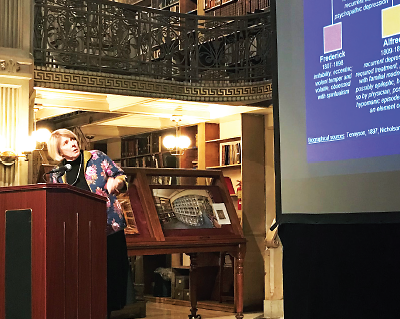Foreboding, fear, and madness are the price of the creativity sometimes associated with mood disorders, Kay Redfield Jamison, Ph.D., the Dalio Professor in Mood Disorders and a professor of psychiatry at Johns Hopkins University, told an audience at Hopkins’ Peabody Conservancy in Baltimore last month.
Jamison, who has written about her own struggles with bipolar disorder, spoke at a symposium on mood disorders and creativity. The symposium’s title, “Carrion-Miles to Purgatory,” comes from verse in Lord Weary’s Castle by the late poet Robert Lowell.
“To hang the Furies by their itching ears, and the green needles nail us to the wall ...
and the snow Blazes its carrion-miles to Purgatory.”
A MacArthur Award recipient and author of a number of acclaimed books, Jamison recently published Robert Lowell: Setting the River on Fire: A Study of Genius, Mania, and Character. She was introduced by James Potash, M.D., director of psychiatry and psychiatrist in chief at Hopkins, who discussed the genetics of bipolar disorder.
The academic part of the symposium was followed by an original musical composition by composer Michael Hersch titled “Images From a Closed Ward,” performed by the Flux Quartet.
Lowell once wrote of his manic episodes: “It was a magical orange grove in a nightmare,” to which Jamison added a stern caveat. While there can be magic, “basically this is a nightmare.” Anyone who has experienced this illness—“including myself … knows how devastating mania is and knows how devastating severe depression is. There’s nothing romantic about it; there’s nothing wonderful about it. But it is also a complicated illness, and mania is a complicated state.”
There is ample statistical evidence of a link between creativity and mood disorders, notably bipolar illness, said Jamison. She believes that particularly in the manic phase of the illness, some people are able to tap into a creative flow.
Statistical analysis has shown that bipolar illness is highly heritable, said Jamison, citing the striking example seen in the family pedigree of writer Alfred Lord Tennyson. The family history reveals a remarkable incidence of violence, mental illness, suicide, and institutionalization. But in Tennyson’s family, there were not only many who suffered from mental illness, but also an unusual number who excelled in creative endeavors.
In the general population, the incidence of suicide is around 0.01 percent—13 per 100,000—while it is much higher among writers and artists, and among poets it is the highest of all, as are the rates of institutionalization, Jamison said.
In large population studies, researchers have found that there is “bimodal distribution” of the intelligence and functionality of people with bipolar disorder, said Jamison. “About a quarter of people with bipolar illness do incredibly well professionally, intellectually, IQ-wise, creation in the arts and sciences, and another quarter does disproportionately badly—really just never make it.” Other population studies have found a bimodal IQ distribution in bipolar illness at both the high and low ends, she added.
Other large population studies have found that those who have been hospitalized for bipolar illness “had a way disproportionate rate of representation in the creative fields, and people with schizophrenia and major depression did not.”
Creative people seeking treatment almost invariably express fear that lithium or other drug treatments will kill creativity, but three-fourths of those treated with lithium say they feel as productive after treatment, Jamison noted. Further, the risks of eschewing treatment are real, including suicide and highly dysfunctional interpersonal relationships.
The symposium closed with the performance of Hersch’s 70-minute, 13-part “Images From a Closed Ward.” The music was accompanied by a video Hersch created that marries fragments of text from Lowell’s poetry with contemporary art and haunting archival photographs of life inside psychiatric hospitals in the early 20th century.
In a brief introduction to the performance, Hersch warned the audience that what they would see and hear was “difficult.” Jamison added: “These are difficult topics. When you are talking about insanity, when you are talking about death, when you’re talking about foreboding and fear and tight horrible spaces, it shouldn’t sing—it would be dishonest.”
The music was jarring and dissonant, and combined with the video, the effect was haunting, harrowing, and bleak. Photographs and black and white drawings scrolled by—psychiatric inmates were shown in various states of despondency, wearing ragged gowns, lying on the floor, or sitting naked on a wooden bench. In one striking photograph, an inmate was flashing a manic smile—a stark contrast to the affect of those around him. And superimposed upon this bleak landscape were wrenching fragments of Lowell’s poetry from Lord Weary’s Castle. ■

